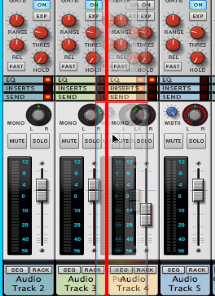Mixer channel strips are automatically created when you create Audio Track and Mix Channel devices. In most situations, a Mix Channel device (with its channel strip) is also automatically created when you create an instrument device (see “Creating devices”).
If there are devices connected to the Mix Channel device you delete, and “Auto-group Devices and Tracks” is selected on the Options menu, the alert will ask if you want to delete only the selected device, or all devices in the Device Group (see “About Device Groups” for more information).
This allows you to e.g. change the Fader levels of all selected channels simultaneously (see “Changing Fader section parameters on multiple channels simultaneously”), or move or delete several channels in one go. The last selected channel will be given edit focus which is indicated by a red strip in the channel header (see “Channel Header section”).
|
|
|
|
Resetting channel settings initializes all channel strip parameters to default values and removes any insert effects (see “Insert FX section”) from the channel.
|
|

